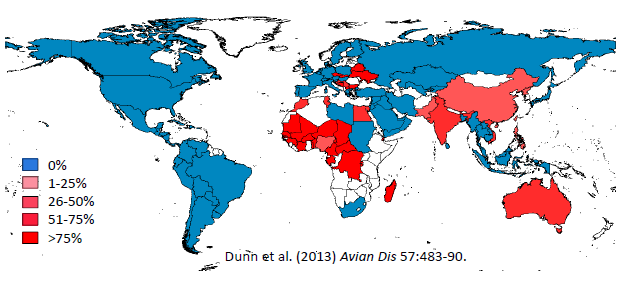



Global Patterns of Marek’s Disease Spread and Vaccination
Marek's disease is an important affliction of poultry flocks worldwide, and can cause mortality rates of up to 100 per cent. A speaker at Merial's Global Avian Forum, in Barcelona in April this year, discussed the prevalence and spread of the disease across the globe.Contamination of poultry houses with Marek’s disease virus is considered to be common because Marek’s disease vaccines do not prevent against infection and subsequent transmission.
"So that's why the virus is generally ubiquitous in most commercial areas - because the virus is present in the vaccinated birds, and then it becomes very difficult to get rid of," said John Dunn, permanent scientist at the US Department of Agriculture's Avian Disease and Oncology Laboratory.
He added: "This is why it's critical for commercial poultry to be vaccinated against Marek's disease."
How is Marek's disease transmitted?
Marek’s disease virus transmission occurs in the feather dust as early as 2 weeks after exposure, peaks at approximately 3-5 weeks and continues indefinitely at quantities as high as 109 virus copies per chicken per day, irrespective of vaccination status.
Infected feather dust can remain infectious in a poultry house for at least several months at 20-25°C and for years at 4°C.
The continuous transmission, long survivability of the virus, and large population of birds all favour a significant viral load within a poultry house, thus requiring constant vigilance and vaccination of all replacement flocks.
Determining global levels of Marek's disease
Although Marek’s disease outbreaks are occasionally reported in the literature, in general it is difficult to determine the global status of Marek’s disease.
There are several reasons for this:
- Marek’s disease is not a notifiable disease;
- Low level losses after Marek’s disease vaccination are generally accepted and treated as normal, since it is known that vaccination failures occur at low frequency;
- Occurrence of Marek’s disease is often linked to financial claims between rearing companies and hatcheries or hatcheries and vaccine manufacturers - often such cases are not made public; and
- Since prevention of the disease requires optimal hygiene and management, besides several other measures, many Marek’s disease cases are not reported in order to avoid damaging the reputation of the company concerned.
The negative effects of immunosuppression caused by Marek’s disease virus infection are even more difficult to estimate.
Although results are subjective, surveys appear to be the best current method for assessing the worldwide status of Marek’s disease. Mr Dunn and his colleagues conducted a survey looking at diagnosis of the disease in 2013 (figure 1).
Figure 1. Percentage of questionnaires indicating frequent Marek's disease diagnosis per country.
Within the US, Mr Dunn and colleagues are able to utilise poultry slaughter condemnation data for young broilers and are able to characterise virus isolates by pathotyping and comparison to historical isolates.
Together, these data provide an important context for worldwide status, which provides a basis for determining current vaccine needs.
The worldwide status of Marek’s disease virus and vaccination
Marek’s disease vaccines have proven to be highly successful in the control of Marek’s disease outbreaks, although outbreaks still occur in vaccinated flocks under some conditions.
In Mr Dunn's most recent worldwide survey, 40 per cent of respondents reported Marek’s disease outbreaks were either never or almost never diagnosed in their country within the last year. Slightly more reported Marek’s disease outbreaks were periodically diagnosed.
Only three reports from Poland, South Africa and Malaysia listed frequent diagnosis of Marek’s disease outbreaks in broiler farms, pullet farms receiving HVT+Rispens vaccination, or on breeder and layer farms receiving double dosage of Rispens, respectively.
Nearly half of those surveyed indicated that Marek’s disease caused significant economic loss during the last year, although this was largely attributed to vaccination costs and vaccination failures.
With respect to disease protection, 82 per cent were satisfied with the protection of currently available vaccines, although 38 per cent indicated that Marek’s disease vaccines with efficacy greater than Rispens would be useful in their operations now.
However, 68 per cent reported that they did not need to increase the use of more protective vaccines for Marek’s disease during the last 5 years in order to maintain adequate control.
In the US, Marek’s disease has remained at historical low incidence since reaching a record low in 2007 (0.0008 per cent) as measured by leukosis condemnation rates in broilers at slaughter.
In Mr Dunn's recent survey, 68 per cent from the US reported that Marek’s disease outbreaks were never or almost never diagnosed in the last year, while 15 per cent reported that the incidence of Marek’s disease has increased during the last 5 years.
Satisfaction with current Marek’s disease vaccines was nearly unanimous, although about 33 per cent reported that they needed to increase the use of more protective vaccines for Marek’s disease during the last 5 years to maintain adequate control.
Mr Dunn said that his team's most recent pathotyping assays of Marek’s disease virus isolates from broiler, breeder and layer flocks matched the pathogenicity of the most virulent strains in their collection, although they found no evidence of a significant shift in virus evolution.
Read more about Marek's disease in our Knowledge Centre here.









